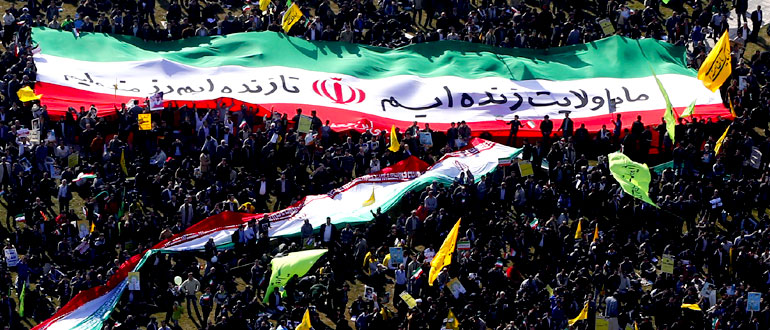Tehran:What are some lessons to be learned from this? One, the Iranian people do not want US politicians deciding and speaking for them, they have made that clear: they want answers from their own politicians. No revolution or attempt to overthrow Iran’s government or ruling system will be successful under the Trump administration or probably ever—USA needs to come to terms with this and move on. Finally, never trust a movement or revolution of any color, especially those reminiscent of the American White man’s meddling and attempted whitewashing of the Persian people and Iranian culture or society.
By Anahita Hamzei
There is a revisited pattern that Iranians are, certainly, aware of each time a new U.S. president takes seat in the oval office; each new president–while there was a hiatus of attempted government coups in Iran as USA grappled at what to do with Iraq—tries, at least, within his first term of initiation to overthrow the Islamic ruling system of Iran. Each president, so far, has nosedived. With experience from Obama-Biden’s meddling and financial squander on the 2009 “Green Movement,” Iranians waited, vigilantly, for U.S.’s next plan of operations in the Islamic Republic; this [Iranian vigilance] was one powerful element that nipped the recent sedition, quickly, in the bud. However, the other major factor that cooled the attempted “White Revolution II” (I will call it the second White Revolution for many factors discussed throughout this article) and led it straight into a brick wall so swiftly, was Donald Trump alone, when simply considering his tactics and rhetoric.
Donald Trump’s plan to ignite a second a “White Revolution,” in the Islamic Republic, failed before it began: it was all too reminiscent of the brutal attempts, initiated by the despised and oppressive Pahlavi dynasty, to westernize the Iranian people and change their culture by force and, in many cases, punishment by torture or death–for those who refused to adopt western culture in Iran. With assimilation tactics written all over it and the dark nostalgia of the Pahlavi era in Iran as a reminder, most Iranians were quick to realize flaws in a revival of another White Revolution, recognizing the tactics that left a stinging sensation of the Shah’s brutality in the eyes of their mothers and fathers.
Hence, Trump’s greatest error emerged from the start, loading up his virtual supporters of Caucasian cyber bullies onto his bandwagon, who mainly used, pro-USA, anti-Islam rhetoric–Pro-Pahlavi and Trump supporters alike, many related to the Shah, took to more extreme measures and promoted Quran burning and violence online–stereotypes and bigotry to justify their pseudo-concerns of the Iranian people and Iran’s economy. Major complaints about the Iranian nation were tweeted and Facebook status’s updated from “patriotic” White commoners and politicians in the USA, who had no known knowledge or education on Iran: these KKK like personas hated the Islamic Republic for simply being Islamic. Not a legitimate argument, in any case, even under their own constitutional observances… Mitt Romney, an ex-presidential hopeful, friend to Donald Trump, and pro-Zionist politician, used American rhetoric of “Patriotism” and vague, unnamed scenarios in support of whatever he perceived to be happening in Iran.
As a result, Iranians who utilized social media, some of which never supported the government until these events unfolded, faced and felt the hatred from Trump’s gang of cyber trolls, who often expressed that hint of white supremacists’ arrogance and ignorance. And almost all of Trump’s groupies went straight for the Iranian Supreme Leader, Ayatollah Khamenei, in their attacks: using violent, disturbing, and derogative rhetoric against a man who is very much loved by the majority of Iranians. Mind you, Khamenei is not just admired in Iran, but all over the world—which, thus, sparked global defense of the Islamic Republic in the midst of White Revolution II.
After the heat and hatred emerged, several anti-government bloggers and writers lost trust in the suspicious “White Revolution II,” and were soon writing in support of the Islamic Republic: “As an activist who participated in many post-2009 protests, now I am skeptical about the motives of these protesters and their targets,” Milad Waseli, a writer and pro-reform activist, said in an L.A. Times news report. “I am surprised. In the past, when we were in a much direr economic situation with even more severe inflation, we did not witness protests like these.”
Additionally, it was hard to ignore the simultaneous occurrence of US media updates and Trump’s tweets, which seemed coordinated and organized, more so than the protests in Iran. What is meant by this is, the political jargon and timing in the Western world, as opposed to what the protestors really wanted in Iran, was much more organized and stated. It was as if there were prior engagements, between the Trump administration and news outlet management, in order to make certain that the Iran events were heard throughout the globe, and they managed this by embellishing the truth entirely. The events in Iran turned out to be a hotter topic in the USA, and other parts of the world, than they ever had been or were to become in Iran.
In his Tweets, Trump stole the media platform from Iranians by making an issue about the Iranian people more about him and his false convictions of the Islamic Republic.
Since 1953, the West (namely the USA and U.K.) has been behind planned demonstrations and coups in Iran: Iranians are very aware of the spins and ploys put forth by the Western World and their vast media enterprise–from generations of experience. When the much debated “protests 2018” began in Iran, it was also an anniversary date which marked the victory of the Islamic Republic over another Western attempt to overthrow Iran’s leadership, under Ahmadinejad: the “Green Movement,”– this was during Barack Obama’s first term. Like the Green-movement the “White Revolution II,” was comparable in the timing that it occurred–the early years of Obama’s first term and Trump’s, respectively. And yet, it was nowhere in comparison to the size and longevity of the Green Movement; which was another factor that led Western media to, desperately, recycle old images of that protests and dig themselves further into a grave of lies; now being buried by the very people they claimed to support.
One of the more infamous tweeters singled out, for spreading lies on the Iranian protests, was this individual, whom tried to pass old footage of a protest in Bahrain as a protest in Iran.
As media caught a whiff of massive demonstrations–all massive protests and demonstrations were pro-Islamic Republic by the way–they took images of these demos and falsified events, virtually, throughout every media outlet in the West, from CNN to BBC, from L.A. Times to Fox news. The feel of Iranians turned from anger at their own system to more distrust and anger towards the West, which, in regions like my own, prompted millions to come out and voice their disapproval of Western interference with internal Iranian affairs. Among the false tweets, half-truths, and reported deaths uprising as a result of Trump’s “White Revolution II,” fed-up Iranians, from all sides of the political pendulum, from all ages and organizations, emerged from their homes, putting aside their laptops and televisions to rise against the U.S. political machine. Thus, Iran proved more united with their leadership than divided.
In another failed attempt by U.S. to overthrow the existing Iranian ruling system, Trump probably failed at his shot more miserably than any of his predecessors, the moment his tweets began. Trump’s phony bologna overshadowed any real and sincere complaints that existed, among whomever the protestors were–this is still a matter up for debate. Any protestors and well-known government activists backed away from Trump’s second “White Revolution” upon getting a hint of what they called, “fishy behavior.” One such activist claimed that she and her friends never joined any of recent protests in Iran because she could sense something, “fishy.”
Reihane Taravati, a social media activist in her 20s called the protesters “fishy and dubious,” according to news reports. “My friends and I don’t identify with them,” Taravati said. “None of my many activist friends have any idea what or who the protesters are, what their agenda is, if they have any at all. Their slogans are weird.”
In large, many Iranians were turned off by Trump’s rhetoric, which they claimed caused more harm than good and were often dishonest. For instance, Trump called riots and violent acts against the Iranian general public “peaceful protests.” While Trump maintained the protests were “peaceful,” nearly a dozen Iranians were verified dead due to the Iranians “protesting.” Several protestors entered Iran illegally, names were dropped and given to security police right away. It was quickly discovered in Iran that the Trump administration used and befriended well known, but on the verge dissolving, terrorist organizations like the MKO (Mujahidin E Khalk) in possibly another failed, but deadly, attempt to overthrow Iran’s government. Because of that operation, Iranian police and soldiers were martyred in a shootout. As violence erupted, any protests that occurred were short lived, the people themselves walked away and put things to a quick and effective end.
What are some lessons to be learned from this? One, the Iranian people do not want US politicians deciding and speaking for them, they have made that clear: they want answers from their own politicians. No revolution or attempt to overthrow Iran’s government or ruling system will be successful under the Trump administration or probably ever—USA needs to come to terms with this and move on. Finally, never trust a movement or revolution of any color, especially those reminiscent of the American White man’s meddling and attempted whitewashing of the Persian people and Iranian culture or society.
*Anahita Hamzei is a graduate from the Texas A&M University System. She holds bachelor degrees in the field of human science and has earned a Master of Science in Sociology. Mrs. Hamzei is an award winning speaker and researcher with published works in various fields of human and life sciences. Her works on Islam and politics are also published throughout various media outlets. Presently, Anahita Hamzei lives in the Islamic Republic of Iran with her family, she writes and lectures on her experiences in an effort to debunk stereotypes and misconceptions spread by western propaganda.



